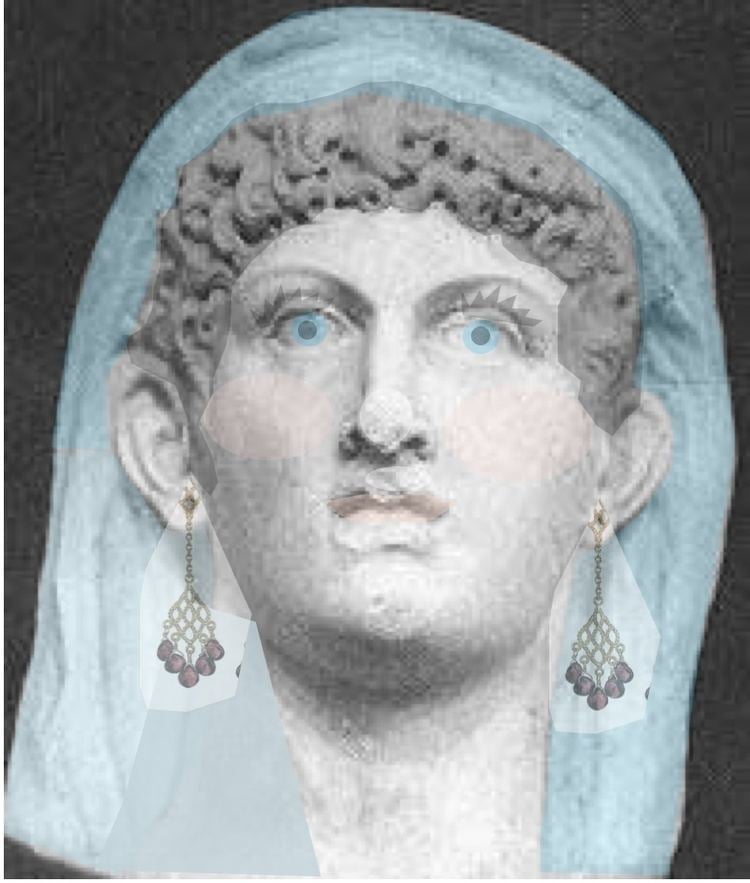Name Cleopatra II Role Princess | ||
 | ||
Issue Ptolemy, King of MauretaniaDrusilla Similar People Cleopatra, Mark Antony, Alexander Helios, Caesarion, Juba II | ||
Cleopatra Selene II
Cleopatra Selene II (Greek: Κλεοπάτρα Σελήνη; late 40 BC – c. 6 BC), also known as Cleopatra VIII of Egypt or Cleopatra VIII, was a Ptolemaic Princess and was the only daughter to Greek Ptolemaic queen Cleopatra VII of Egypt and Roman triumvir Mark Antony. She was the fraternal twin of Ptolemaic prince Alexander Helios. Her second name in ancient and modern Greek means moon, also meaning the Titaness-Goddess of the Moon Selene, being the counterpart of her twin brother‘s second name Helios, meaning sun and the Titan-God of the Sun Helios. She was of Greek and Roman heritage. Cleopatra was born, raised and educated in Alexandria, Egypt. In 36 BC in the Donations of Antioch and in late 34 BC during the Donations of Alexandria, she was made ruler of Cyrenaica and Libya.
Contents

Early life

Cleopatra Selene had two full brothers, her twin Alexander Helios and the younger Ptolemy Philadelphos. Her older half-brother, Caesarion, was a product of her mother's brief relationship with Julius Caesar before his assassination. Her father also had five other children with previous wives.

Her parents, Mark Antony and Cleopatra VII, were defeated by Octavian (future Roman Emperor Caesar Augustus), during a naval battle at Actium, Greece in 31 BC. In 30 BC, her parents committed suicide as Octavian and his army invaded Egypt. Octavian captured Cleopatra and her brothers and took them from Egypt to Rome, parading the three orphans in heavy golden chains in his triumph. The chains were so heavy that the children were unable to walk in them, eliciting unexpected sympathy from many of the Roman onlookers. Octavian gave the siblings to his elder sister (and Mark Antony's former wife) Octavia Minor to be raised in her household in Rome.
Marriage
Between 26 and 20 BC, Augustus arranged for Cleopatra to marry King Juba II of Numidia in Rome. The Emperor Augustus gave to Cleopatra as a wedding present a huge dowry and she became an ally to Rome. By then her brothers, Alexander Helios and Ptolemy Philadelphus, disappear from all known historical records and are presumed to have died, possibly from illness or assassination. When Cleopatra married Juba, she was the only surviving member of the Ptolemaic dynasty.

Juba and Cleopatra were unable to return to Numidia after it was annexed as a Roman province in 46 BC. Instead, the Roman authorities sent the couple to govern Mauretania, a region that lacked organized governance and required Roman oversight. They established their new capital at Caesarea (present-day Cherchell, Algeria), naming it in honor of the Roman Emperor. Cleopatra reportedly had significant influence on the administrative and policy decisions made by Juba during their rule. Through her influence, the Mauretanian Kingdom flourished. Mauretania exported and traded well throughout the Mediterranean. The construction and sculptural projects at Caesarea and at another city Volubilis, were built and display a rich mixture of Ancient Egyptian, Greek and Roman architectural styles.
The children of Cleopatra and Juba were:
Zenobia of Palmyra, Queen of Syria, claimed descent from Cleopatra, although this is unlikely.
Death
Controversy surrounds Cleopatra's exact date of death. A discovered hoard of Cleopatra's coins was dated at 17 AD. It has traditionally been believed that Cleopatra was alive to mint them; however, this would mean that Juba married the Cappadocian Princess, Glaphyra during Cleopatra's lifetime. To explain this strange marital problem, historians have supposed some sort of rift between Cleopatra and Juba that was eventually mended after Juba's divorce from Glaphyra. Modern historians dispute the idea that Juba, a thoroughly Romanized king, would have taken a second wife. The argument goes that if Juba married Glaphyra before 4 AD then his first wife, Cleopatra, must have already been dead. (The counterargument can be made that even contemporary client kings with Roman citizenship, such as Herod the Great, took multiple wives, and that Juba's father had more than one.)
The following epigram by Greek Epigrammatist Crinagoras of Mytilene is considered to be Cleopatra’s eulogy.
The moon herself grew dark, rising at sunset,Covering her suffering in the night,Because she saw her beautiful namesake, Selene,Breathless, descending to Hades,With her she had had the beauty of her light in common,And mingled her own darkness with her death.If this poem is not simply literary license, then astronomical correlation can be used to help pinpoint the date of Cleopatra's death. Lunar eclipses occurred in 9, 8, 5 and 1 BC and in AD 3, 7, 10, 11 and 14. The event in 5 BC most closely resembles the description given in the eulogy, but the date of her death is simply not ascertainable with any certainty. Zahi Hawass, former Director of Egyptian Antiquities, believes Cleopatra died in AD 8.
When Cleopatra died, she was placed in the Royal Mausoleum of Mauretania in modern Algeria, built by her and Juba east of Caesarea and still visible. A fragmentary inscription was dedicated to Juba and Cleopatra, as the King and Queen of Mauretania.
